|
Notes: Travelling from Oxford in the direction of Cambridge, Blunham was the first station on the Varsity Line which was built in the architectural style of the Bedford & Cambridge Railway, a style which included strong gables in yellow gault brick together with red brick dressings and string courses. As with the other Bedford & Cambridge-built stations with the exception of Potton, the main station buildings were situated on the down side and comprised a two-storey stationmaster's house with the booking office on the lower floor. There was a single storey wing on the west side which formed and open-fronted shelter with a toilet block with narrow vented windows at its west end. An unusual wooden open-fronted shelter served for passengers on the up platform. The two platforms were low and steps were often needed to reach coaches, illuminated at night by the station's oil lamps. The platforms were surfaced with Staffordshire paviors with stone edging. Although the line was single track the station had a very long passing loop. The loop was lengthened in both world wars giving the impression to anyone standing on the platform that the line was double track.
 There was a small good yard on the down side. There was a long loop siding to the west of the station and a shorter siding which served a cattle dock on the down side before running through a substantial brick goods shed built to a typical LNWR design, before terminating at the rear of the down platform. The goods shed contained a 25cwt crane. In 1879 a signal box with a 30-lever frame was provided on the up platform opposite the good shed. This controlled access to the goods yard and a long siding the the east of the station that ran one third of a mile to a linseed oil on the banks of the River Ivel.The station, like many others on the Bedford & Cambridge's line, saw considerable vegetable traffic - notably potatoes, leading to special trains being laid on to arrange for the collection of goods for carriage to Bletchley and onward transport to London. The station also had a healthy trade in bananas. There was a small good yard on the down side. There was a long loop siding to the west of the station and a shorter siding which served a cattle dock on the down side before running through a substantial brick goods shed built to a typical LNWR design, before terminating at the rear of the down platform. The goods shed contained a 25cwt crane. In 1879 a signal box with a 30-lever frame was provided on the up platform opposite the good shed. This controlled access to the goods yard and a long siding the the east of the station that ran one third of a mile to a linseed oil on the banks of the River Ivel.The station, like many others on the Bedford & Cambridge's line, saw considerable vegetable traffic - notably potatoes, leading to special trains being laid on to arrange for the collection of goods for carriage to Bletchley and onward transport to London. The station also had a healthy trade in bananas.
In the early years of the 20th century longer trains began operating on the Oxford - Cambridge line and the platforms were lengthened to accommodate these on 3 August 1916.
 The station served a relatively rural community - there were 598 residents in 1901 - and this, coupled with its remote location to the south of Blunham village, left it susceptible to competition from the motor car. The goods yard closed on 13 July 1964 although a private siding remained in use after that date. Within two years the sidings had been lifted and the goods shed had been demolished. Although the line survived Beeching the up platform was shortened as it now only had to accommodate 2-car DMUs. The station served a relatively rural community - there were 598 residents in 1901 - and this, coupled with its remote location to the south of Blunham village, left it susceptible to competition from the motor car. The goods yard closed on 13 July 1964 although a private siding remained in use after that date. Within two years the sidings had been lifted and the goods shed had been demolished. Although the line survived Beeching the up platform was shortened as it now only had to accommodate 2-car DMUs.
BRIEF HISTORY OF THE OXFORD -
CAMBRIDGE RAILWAY (Bedford - Cambridge section)
The Bedford & Cambridge Railway Bill was put before parliament
in 1860 and despite objections from the Eastern Counties Railway
the Bill received the Royal Assent on 6th August. As part of the
Act, the new Bedford & Cambridgeshire Railway bought out the
Sandy & Potton Railway which had opened in 1857 from Sandy
to a terminus on Biggleswade Road, Potton.
Work on the line began in April 1861 with the short lived Sandy
& Potton Railway closing in December 1861. Much of the route
was re-laid and Potton Station was resited close by.
The first train containing directors and shareholders of the
company departed from Bedford at 9.04 on 4th July 1862, arriving
at Cambridge at 1.30 pm. Three days later the line was officially
opened for goods traffic and to passengers on 1st August, finally
linking the two university cities of Oxford and Cambridge.
The Bletchley to Bedford line had opened in 1846 and the opening
of the Bedford to Cambridge line provided an important cross country
link between Oxford and Cambridge forming one of the few east-west
routes, with the capability of reaching the east coast ports.
Most services however ran from Oxford to Bletchley and from Bletchley
to Cambridge.
Intermediate stations were built at Blunham, Potton, Gamlingay,
Old North Road & Lords Bridge and a bay was provided at the
recently rebuilt Cambridge Station to accommodate the Oxford and
Bedford trains. At Sandy the trains from Bedford crossed over
the Great Northern line on a lattice bridge running down into
the new station which was located alongside the Great Northern
station. A new station at Willington was added in 1906 and in
1938 a new halt was opened at Girtford between Blunham & Sandy;
this was short lived however closing two years later.
From the offset the train service was run by the London &
North Western Railway absorbing the Bedford & Cambridge Railway
in July 1865
 In 1955 The Railway Modernisation Plan proposed improvements
in cross country facilities between Oxford and Cambridge with
the aim of maintaining a link between the major main line railways
outside the congested Greater London area thereby allowing freight
traffic to be transferred between three railway regions and easing
the burden on London marshaling yards. Within a few years the
policy changed and the line was not upgraded with the Bletchley
flyover remaining as a monument to the fruitless proposal. In 1955 The Railway Modernisation Plan proposed improvements
in cross country facilities between Oxford and Cambridge with
the aim of maintaining a link between the major main line railways
outside the congested Greater London area thereby allowing freight
traffic to be transferred between three railway regions and easing
the burden on London marshaling yards. Within a few years the
policy changed and the line was not upgraded with the Bletchley
flyover remaining as a monument to the fruitless proposal.
An attempt was made to close the Oxford - Bletchley - Cambridge
line in 1959 but local pressure succeeded in winning a reprieve.
There was some relief when Dr. Beeching did not include the cross
country Oxford to Cambridge line in his closure proposals in 1963
but just one year later, the British Railways Board published
closure plans for the whole route. The introduction of new diesel
trains in the 1960's allowed British Railways to run much faster
trains and the need for a cross country service declined as passengers
found it quicker to travel from Oxford to Cambridge via London.
The line closed after the last day of service on 30th December
1967 although the section between Bletchley and Bedford remained
open.
Track lifting of the Bedford - Cambridge Line began on 13th August
1968. Track was left in place between Potton and Gamlingay pending
negotiations for preservation by the Sandy & Potton Steam
Railway Society. Unfortunately the Society was unable to raise
sufficient funds and the 5.25 miles of track was eventually lifted.
One section of the bed between Lords Bridge Station and the junction
with the GER has become the site of a very long radio telescope
belonging to the Mullard
Radio Astronomy Observatory (Part of Cambridge University).
The long level straight stretch of line was ideal for this telescope
which is rail mounted, the track has however been re-laid and
the gauge is now about 12 feet!
Route map drawn by Alan Young, tickets from Michael Stewart.
Sources:
- Oxford to Cambridge Railway (Volume 2 Bletchley - Cambridge)
by Bill Simpson - Oxford Publishing Company 1981 ISBN 86093
121 8
- Forgotten Railways - East Anglia by R S. Joby - David &
Charles 1975
ISBN 0 7153 7312 9
For more pictures of Blunham Station in 2006 click
here
To see the other
stations on the Oxford - Cambridge line click on the station name:
Oxford Rewley Road, Port
Meadow Halt, Wolvercote
Halt, Oxford
Road Halt, Islip,
Oddington
Halt, Charlton
Halt, Wendlebury
Halt, Bicester
London Road, Launton,
Marsh
Gibbon & Poundon, Claydon,
Verney
Junction, Winslow,
Swanbourne,
Bedford
St. Johns, Willington,
Girtford
Halt, Sandy,
Potton,
Gamlingay,
Old North
Road & Lords
Bridge - see also The Bedford
Railway (stations still open)
|

old1.jpg)
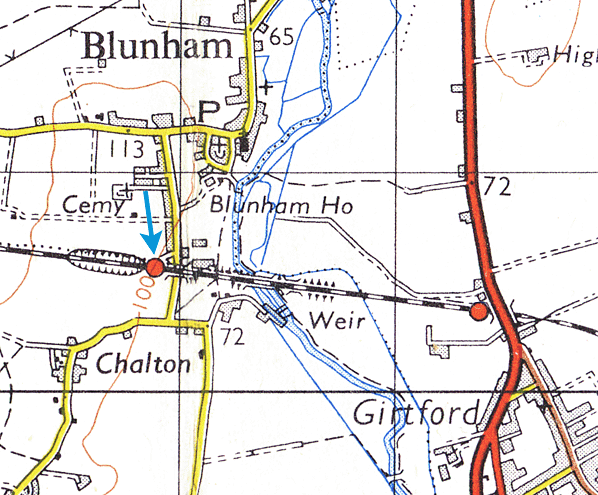
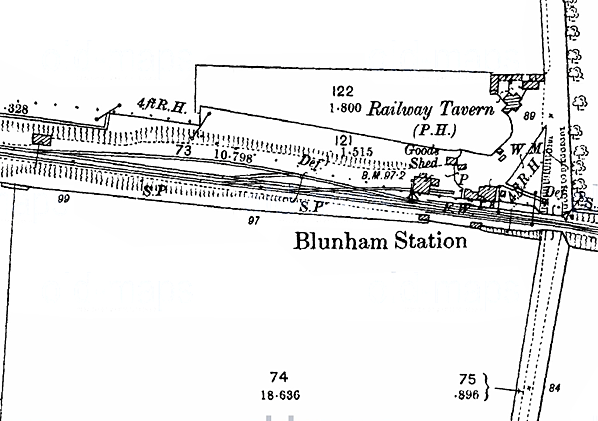
old2.jpg)
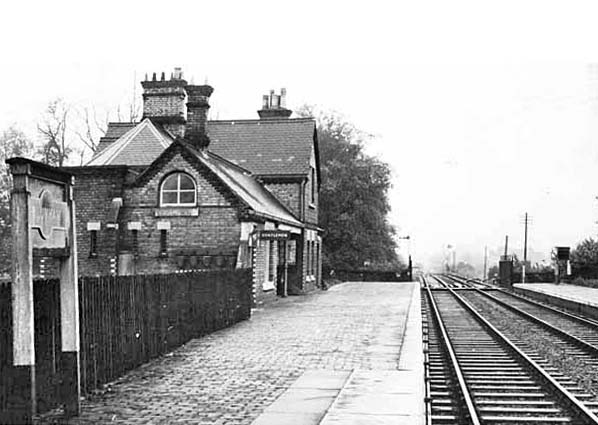
old3.jpg)
old5.jpg)
old6,jpg.jpg)
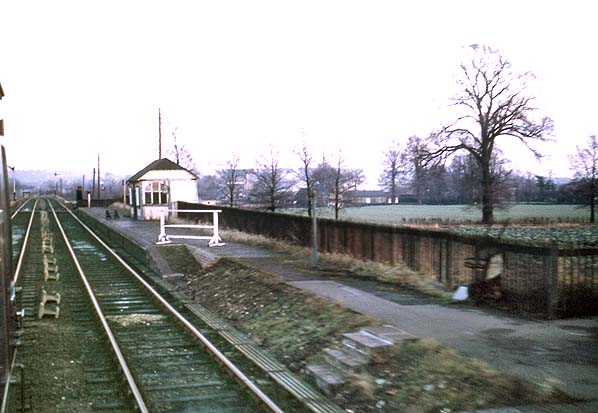
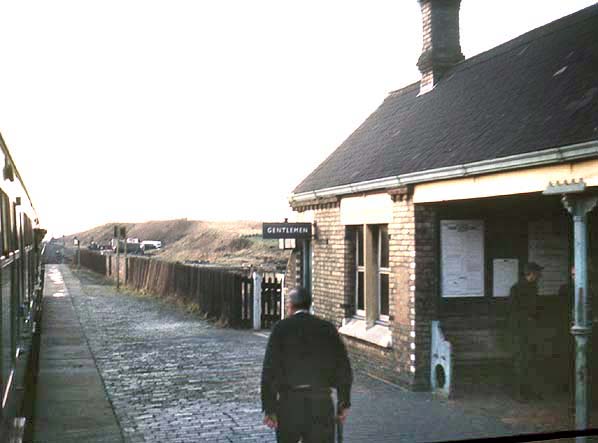
20.jpg)
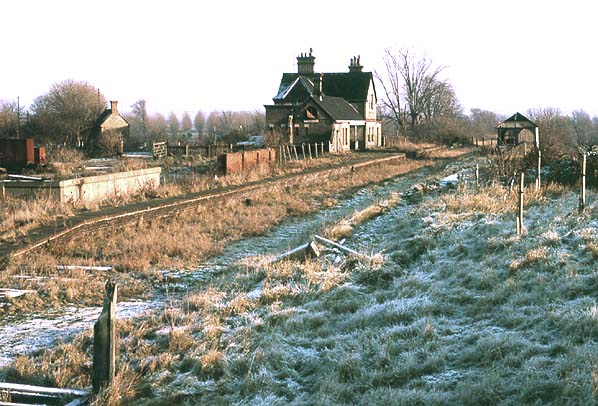
18.jpg)
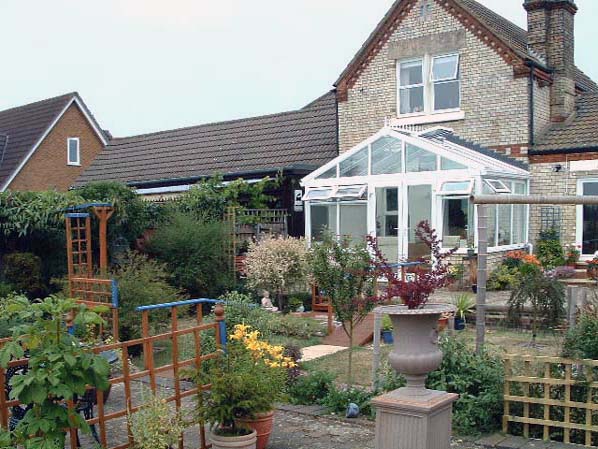
 Home Page
Home Page  There was a small good yard on the down side. There was a long loop siding to the west of the station and a shorter siding which served a cattle dock on the down side before running through a substantial brick goods shed built to a typical LNWR design, before terminating at the rear of the down platform. The goods shed contained a 25cwt crane. In 1879 a signal box with a 30-lever frame was provided on the up platform opposite the good shed. This controlled access to the goods yard and a long siding the the east of the station that ran one third of a mile to a linseed oil on the banks of the River Ivel.The station, like many others on the Bedford & Cambridge's line, saw considerable vegetable traffic - notably potatoes, leading to special trains being laid on to arrange for the collection of goods for carriage to Bletchley and onward transport to London. The station also had a healthy trade in bananas.
There was a small good yard on the down side. There was a long loop siding to the west of the station and a shorter siding which served a cattle dock on the down side before running through a substantial brick goods shed built to a typical LNWR design, before terminating at the rear of the down platform. The goods shed contained a 25cwt crane. In 1879 a signal box with a 30-lever frame was provided on the up platform opposite the good shed. This controlled access to the goods yard and a long siding the the east of the station that ran one third of a mile to a linseed oil on the banks of the River Ivel.The station, like many others on the Bedford & Cambridge's line, saw considerable vegetable traffic - notably potatoes, leading to special trains being laid on to arrange for the collection of goods for carriage to Bletchley and onward transport to London. The station also had a healthy trade in bananas. The station served a relatively rural community - there were 598 residents in 1901 - and this, coupled with its remote location to the south of Blunham village, left it susceptible to competition from the motor car. The goods yard closed on 13 July 1964 although a private siding remained in use after that date. Within two years the sidings had been lifted and the goods shed had been demolished. Although the line survived Beeching the up platform was shortened as it now only had to accommodate 2-car DMUs.
The station served a relatively rural community - there were 598 residents in 1901 - and this, coupled with its remote location to the south of Blunham village, left it susceptible to competition from the motor car. The goods yard closed on 13 July 1964 although a private siding remained in use after that date. Within two years the sidings had been lifted and the goods shed had been demolished. Although the line survived Beeching the up platform was shortened as it now only had to accommodate 2-car DMUs.
 In 1955 The Railway Modernisation Plan proposed improvements
in cross country facilities between Oxford and Cambridge with
the aim of maintaining a link between the major main line railways
outside the congested Greater London area thereby allowing freight
traffic to be transferred between three railway regions and easing
the burden on London marshaling yards. Within a few years the
policy changed and the line was not upgraded with the Bletchley
flyover remaining as a monument to the fruitless proposal.
In 1955 The Railway Modernisation Plan proposed improvements
in cross country facilities between Oxford and Cambridge with
the aim of maintaining a link between the major main line railways
outside the congested Greater London area thereby allowing freight
traffic to be transferred between three railway regions and easing
the burden on London marshaling yards. Within a few years the
policy changed and the line was not upgraded with the Bletchley
flyover remaining as a monument to the fruitless proposal.